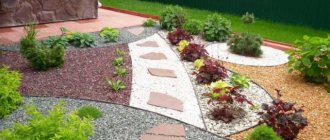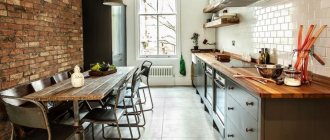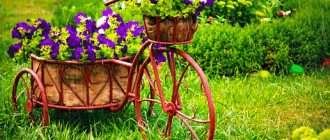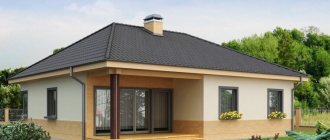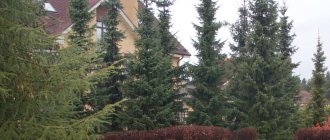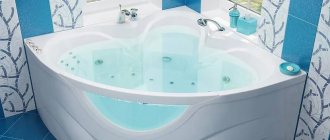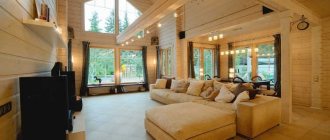Almost every personal plot has a flower garden. It is able to diversify landscape design and add bright colors to it. This can be a central element around which a recreation area, a play area, or a connecting link between the house and colorful plantings will be grouped.
In any case, the design of a flower garden must be taken with full responsibility. Here it is important to choose the right shape of flower beds, choose flowers, and think through the decor. In this article we will look at the advantages of round flower beds, their harmonious location on the site, popular planting schemes, choice of vegetation and much other useful information.
What are vertical flower beds
A vertical flower garden cannot be called know-how; this method of landscaping has long been successfully used by city services in many localities.
With the same success, a similar method of organizing flower beds can be used in private areas.
Even if the area allows and the territory pleases with rose gardens, flower beds and green plantings, vertical flower beds will add their own flavor to the organization of the landscape, allowing you to zone the area and focus attention on something.
To make raised flower beds, you will need some materials and a little imagination.
Places for installing flower beds
For vertical compositions with flowers and greenery there are no frames limiting the size or shape, so they can be placed literally anywhere in the summer cottage:
- a cascading flower bed will decorate the entrance area to the house, to the terrace, to the gazebo;
- You can decorate the fence with boxes of flowers and greenery, making the border less official;
- a flowerbed hidden in a bush, cascading or vertical, will enliven the corner during the period when the flowering of the bush ends;
- tall towers will brighten up the corners of the site;
- Hanging flowerpots, in a certain geometric or chaotic order, will look elegant not only at the entrance to the house, but also on the wall, near the bench.
Depending on the type of construction, there are:
- wall;
- wall;
- ground;
- hanging flower beds.
In a word, any boring corner can be enlivened by arranging even a low vertical of several pots or flowerpots.
Sedum
Sedums are unpretentious plants, mostly resistant to all kinds of weather vagaries. They like to be planted in rock gardens and rockeries, along paths and in other places where they can grow freely.
Ground cover species of sedums are suitable for a green roof. For example, cornflower sedum, hybrid sedum, thick-leaved sedum, Kamchatka sedum, false sedum, spatulate-leaved sedum, multi-stemmed sedum, thick-leaved sedum, and Evers' sedum are popular with gardeners.
Sedums, like all succulents, are drought-resistant and do not like excessive moisture. That is why they are unlikely to be suitable for landscaping a roof without a slope - during rains the plants may simply rot.
Look for the classification of sedums in our material Types of garden sedums - photos, names and popular varieties
Advantages and disadvantages
Vertical flower beds have their pros and cons. The latter are solvable and not so critical as to give up the idea of using original, fresh solutions in landscape design.
Advantages:
- saving space. Arranging pots or boxes one above the other allows you to place a large number of plants in a relatively small area;
- the proximity of crops that in the open ground interfere with each other or “are at enmity.” It's no secret that not all plants can be planted nearby. A completely natural struggle for minerals and water arises when the fittest survives. Vertical solves such problems;
- in pots or other containers planted with flowers, practically no weeds grow (especially if the soil has been prepared in advance), there are no pests;
- originality of construction and individual design will make the site different from others.
Flaws:
- a small volume of soil requires regular fertilizing;
- outside, the soil in pots dries out quickly, there is no groundwater, so frequent watering of the plants is required to maintain the beauty of the greenery and flowering;
- In winter, the roots of perennials left outside freeze very much. It is recommended to make the structure collapsible (containers with flowers are removable) in order to put them in the basement or cellar during the cold period.
Build process
Assembly begins with the largest pot. It is filled with soil about 1/2. After this, a wooden or metal rod is placed in the center, onto which the remaining pots are placed from larger to smaller diameter, partially filling them with earth.
In this case, plants should be planted in a circle. As they grow, the pots will become less noticeable. Watering is carried out if necessary.
Types of vertical flower beds
Ideas for vertical flower beds can be gleaned from the Internet, but you should not limit yourself to ready-made forms: if you add imagination, you will be able to create your own, individual project.
flower tower
The flower garden, decorated in the “tower” style, has an absolutely stunning view. Strictly speaking, the shape of the tower can be any you choose: spherical, spherical, cubic, arbitrary. The main thing is that the tower is a figure filled with soil in which plants are planted. During the flowering period, it is completely covered with petals and the frame is not visible at all.
Flower ball
Special frames are sold for flower balls; you can build something similar with your own hands. The ball is filled with soil into which the plants are planted.
On the ground, the flowerbed will not look as advantageous as it does in limbo. During the flowering period, raised and suspended “balls” immediately attract attention.
Screen
As expected, a screen is used to disguise unattractive walls, boring buildings, or to zone a site. A wooden, plastic, metal “screen” planted with bright fragrant flowers will cope with its role perfectly.
Blooming pillar
The design resembles a “tower”, but unlike it, it has a strict cylindrical shape. The column can be organized in the form of a cascade, but, as a rule, it is a hollow cylinder with an organized irrigation system, planted with flowers.
Tunnel
The “tunnel” type design looks very original - high metal arches, “covered” with containers with plantings on top. Despite its unconditional beauty and originality, such a flower bed is very difficult to water; this must be taken into account in advance. Although, of course, the hanging species planted on the “roof” of the tunnel are a unique sight, such decor is used to organize various types of special events.
Hanging flowerpots
The simplest, and therefore the most common type of vertical flowerbed with your own hands is a support on which hanging pots with soil and plantings are attached. They can be placed anywhere on the site, using a fence, beams of a house or other buildings, even garden trees for the frame.
What to plant - onions or perennial flowers?
Not everything in the garden should be for the belly, you need to leave room for “beauty” - just for the soul. A flowerbed of continuous flowering perennials can easily decorate even the most inconspicuous area, giving it a unique charm. Roses, geraniums, carnations, poppies and asters will grow in the same place season after season without requiring special attention.
A question that every novice gardener must understand is the choice of plants for a perennial flower garden. From practical experience, the first flowerbed should be made small and planted with unpretentious flowers that grow well under the bright sun.
A flowerbed is a bright element of the garden, so there is no point in planting it in the far corner of the site or hiding it under the shade of trees. The optimal solution for creating a perennial flower bed would be a place that is clearly visible from all sides.
Multi-level flower beds (with tall plants in the background and short ones in the foreground) are usually placed near the walls of a house, a fence or hedge. Whereas in the center of the site, a constantly blooming flowerbed of perennials can either form all sorts of combinations of plants, or be decorated with only one species.
Flowerbeds of perennials in the garden and country house
Posting rules
When creating a flowerbed, you should adhere to several recommendations. They will help make the design harmonious.
- You should not chase the abundance of species and number of plants. An overloaded flower bed looks sloppy, and flowers that are planted in vertical structures suffer from a deficiency of minerals and water. When planting plants, you need to make gaps of 5-7 cm between them.
- Three to five plant species for one “tower” is optimal.
- The colors of the buds should be combined and in harmony with each other, in addition, you need to think about whether the plants will bloom at the same time or replace each other.
- Gaps and voids can be disguised with the help of decorative elements, greenery, and grass.
- It is necessary to give preference to plant species with a shallow root system; they will do well in a limited space.
tall plants
Interesting options with a height of up to 80 cm are:
- Gladioli;
- Geranium;
- Astilbe;
- Delphinium;
- Daisies.
The choice depends on the level of illumination of the area. Chamomiles prefer an abundance of light, Delphinium and Geranium are unpretentious, and Gladioli and Astilbe love shade. Optimal specimens are determined individually.
Types of purchased structures
Today, specialized stores offer a wide range of ready-made designs that allow you to quickly and easily make a vertical flower bed with your own hands. These include wooden multi-level “pyramids” that can be moved around the site; wooden “ladders” with pallets; decorative flower pots and stands; pallets, metal and wooden boxes of various sizes; metal balls made of wire.
If you wish, you can realize your own needs and fantasies by making a custom-made structure based on an individual project. The only negative is the cost of such structures. Therefore, summer residents simply make do with what they have at hand, turning even household garbage and waste into stunning flower beds.
Creating a continuous flowering cycle
When making a flower bed of flowering perennials, it is important to take care of the correct change in the order of budding of plants. With the right approach to the selection of components, it is easy to ensure continuity of the flowering cycle.
Varieties are selected in such a way that the flowering sequence is observed one after another. It is not difficult to find seedlings that will provide gradation from May to October.
How to make a vertical flowerbed with your own hands using improvised materials
Creating flower beds with your own hands at the dacha is not at all difficult. You can use everything that has long been asked to be thrown into the trash, but for some reason has not yet gone there. It's time to give old junk a second life.
From plastic bottles
Even first-graders know that plastic takes centuries to decompose. But if separate waste collection is organized in the city, when recycled plastic containers are recycled, then problems arise with this outside the city. And there are quite a few bottles of water and drinks collected in the country house. It's time to use them for a good cause.
- Five-liter drinking water bottles are very convenient. They need to cut off the neck or bottom (and turn them over by screwing on the lid) to create a wide, capacious container.
- Two-liter bottles are also cut to half (they often use half with a neck, hanging the lid down, such pots look impressive).
- The bottle can be placed horizontally by cutting out a spacious hole on one side for soil and planting flowers.
Bottles with plantings can be mounted on a fence, wall, or used to decorate a screen.
From the boxes
Boxes made of wood or plastic are naturally ideal containers for organizing a flowerbed with your own hands. Boxes of different sizes can be placed vertically on top of each other (after filling them with soil), and seedlings can be planted in the resulting gaps, thus creating a cascading flower garden.
If the boxes are the same size, then plants can be planted in the spaces between the slats or in the side holes.
The boxes can be placed on the ground, nailed to a wall, mounted on a fence, or used to make decorative “border” posts.
Made from metal mesh and garden film
If you cut off about a meter of chain-link mesh, cover it from the inside with thick plastic film or black spunbond, securing it in the corners, and then roll the mesh into a cylinder and connect the edges, you will get the basis for a high flower bed. You need to make holes in separate cells (in a checkerboard pattern) in which flowers will be planted.
The cylinder is placed in a wooden or plastic container (bucket) and firmly fixed (you can bury the bucket in the ground). You need to install a plastic pipe in the center, first drilling holes in it for irrigation and sealing the bottom hole (which will stand at the bottom of the bucket). The gaps between the walls and the pipe must be filled with soil mixture and flowers planted.
From geotextile
Geotextiles are a convenient material for making a vertical flower bed. The frame is made of reinforcement bars installed in a circle. On the outside, they are wrapped in several layers of geotextile; holes for seedlings need to be made in it in random order.
The watering system is the same as in a flowerbed made from a chain-link mesh: in the center there is a plastic tube with holes for water, with an insulated bottom edge. The space between the geotextile walls and the water tube is filled with soil. In both cases, it is recommended to make a drainage layer at the bottom.
From a pallet
Wooden pallets are a convenient, eco-friendly material that will last a long time faithfully. Pallets can be used to make a wonderful screen or raised flower bed.
In the first case, the pallet must be turned with its back (“legs”) forward, and using small nails or a furniture stapler, secure the geotextile folded in several layers so that it forms a bag. Pour soil into it and plant flowers.
Put together a kind of box from several pallets and plant flowers in it, raising them above the ground.
Pallets must be sanded and covered with a colorless or decorative protective material. You can decorate a flower bed made of wooden pallets with colored paints.
Using other items
By “other items” we mean everything that is lying around underfoot. For example, old shoes. Daisies will look great in rubber boots and galoshes nailed to the fence. Petunias will look great in an old umbrella turned upside down with its handle. Violets look very cute in small cups suspended one above the other. You just need to look around and use your imagination.
Watering cans, buckets, basins
There is also plenty of this goodness in the dacha! They can be raised above the ground by installing them on stands, stumps, steps, benches, or, on the contrary, dug into the ground.
You can also add old pots, deep frying pans, boiling pots and buckets here. The main thing is not to forget to water the plants. And remember that metal “flower beds” are subject to corrosion from contact with water, so you need to monitor their condition.
Tires and Tires
Car tires and tires are classics of country house decor; they have been used for a long time to fence flower beds.
But if you stack the tires on top of each other, or in some other order, and fill the voids with soil, plant plants, and you will get a vertical flower bed. Tires can be dug into the ground, hung on a tree, cut into two parts and attached to each of them on a wall (fence). Tires can be painted in different colors, braided with decorative cord, and turned into flowerpots.
Plastic pipe
You can make a pillar or tower from a plastic pipe of a suitable diameter: you need to cut holes in it in a checkerboard pattern (5-6 cm in diameter). Inside, in the center, place a pipe of smaller diameter with holes drilled in it.
Fix the structure in the ground, fill the pipe cavity with soil and plant the seedlings in the prepared holes. The inner thin pipe is designed for watering.
Pots and containers
It’s very easy to organize a vertical flower bed with pots and containers: they need to be secured in “floors” or in a cascade on a fence, wall, or wooden pallet; you can build a pole with hooks and hang pots; containers can be installed on special stands, shelves - in a word, you can give free space to your imagination. Pour soil into pots and containers and plant flowers. Bright colors of pots will make the flower bed attractive.
Barrels and containers
You can also organize a flower garden in wooden barrels and tubs. To do this, you need to install a watering pipe in the central part, fill the barrel with soil, cut holes in the sides with a diameter of about 5 cm and plant the plants.
Examples of the best flower beds for a summer residence
As they say, it is better to see once than to read five times. Therefore, let's look at the most successfully implemented flower beds. Maybe you will like some ideas and you can implement them at your dacha.
How to choose suitable flowers for vertical flower beds
Choosing suitable plants is a crucial moment in organizing a vertical flower bed. The appearance of the flower garden and the corner where it will be installed depends on how correctly and successfully they are selected.
It is recommended to choose plants that are unpretentious, easy to care for, resistant to rain, drought, disease and temperature changes, do not grow very much, and have a shallow root system.
Annuals are preferable to perennials, despite the fact that seedlings will have to be grown every year. Especially if we are talking about a stationary flower bed without the ability to put the containers away in the basement or cellar for the winter. The root system of flowers freezes strongly and they may die. An exception can be made in southern regions with warm winters.
But the main thing is to select plants that will delight the eye with long, abundant flowering, bright or delicate buds.
Petunias
Classics of the genre - petunias. The variety of shades in which the bell-shaped petunia flowers are painted is amazing:
- white,
- soft pink,
- scarlet,
- lemon,
- raspberry,
- lilac,
- purple,
- with stripes,
- motley,
- two-color.
Large and small, erect and ampelous, petunias cover the soil with a bright carpet and bloom desperately until frost (with proper, not very difficult care).
Nasturtiums
Yellow and red nasturtium flowers will decorate any flower bed. Curly shoots will entwine the vertical structure, hiding the frame under spectacular greenery and wide leaves.
The flowers are double and semi-double, but both are very beautiful and fragrant.
Lobelia
Such a changeable lobelia has recently become a favorite of gardeners again. Its small fragrant flowers (bluish, pink, white) decorate the flower garden for a long time.
Lobelia has cascading, ampelous, and compact varieties; it is unpretentious in care.
Balsams
With their dark green fleshy foliage, translucent stems and bright flowers, they have become popular again, only now as outdoor plants.
They feel great in flower beds, bloom for a long time and do not cause problems. There are many varieties, you can choose the one you like best.
Nemesia
It seems like it was specially created for voluminous textured flower beds. Flowers with a tubular corolla can be painted in a variety of colors: white, pink, yellow, red, blue, or a combination of two colors. They are quite heavy and under their weight the stems bend, hanging beautifully.
Godetia
Neat, erect godetia bushes grow up to half a meter in height; it is important to form a crown in a timely manner.
Simple or double flowers are bell-shaped, painted white or one of the shades of red; some varieties have complex combined coloring of the petals.
Begonia
Begonia is extremely popular in garden floriculture. It is hardy, unpretentious, and is used not so much for its inconspicuous small flowers (although many people like them), but for its decorative, variegated leaves.
As a rule, evergreen begonia and tuberous begonia are used for landscaping.
Coleus
Unsurpassed in its decorativeness, coleus is truly amazing. Its leaves, depending on the chosen variety, can be greenish, lemon, yellow, pinkish, crimson, purple, and have a contrasting edging.
The combination of coleus of different colors makes the flower bed a real miracle. Coleus are unpretentious and extremely easy to care for.
Brachycoma
Brachycoma looks simple but elegant in a vertical flowerbed. This plant has delicate thin foliage and branches well, quickly growing over the given area.
It blooms with small white, blue, bluish or lilac flowers, collected in baskets of four.
Alyssum
People affectionately nicknamed him “Alyssum.” Alyssum can often be found in country house design.
The low (up to 40 cm) stems of alyssum are highly branched and become woody at the base. Small fluffy flowers are collected in inflorescences and can be colored white, yellow, pink, red or purple.
The pronounced spicy, sweetish aroma attracts pollinating insects.
Eschszolzia
A distant relative of the poppy. Its flowers are painted milky white or deep yellow.
Even though the “lifetime” of one bud is three days, there are a lot of flowers and flowering in general lasts a long time, which is why eschscholzia is a favorite of many gardeners.
Marigold
Old friends, but still beloved marigolds can bloom for quite a long time without special care. Numerous varieties - tall and short, with large heads and small flowers, delight the eye until late autumn, saturating the air with a spicy, tart, bitter aroma.
Pansies
These flowers also do not need any special introduction. These low-growing flowers with stunning “velor” buds of complex colors are not in vain loved and grown in flower beds for so many years.
Pansies begin flowering early, which continues until mid-autumn; they are unpretentious and very beautiful.
Greenery
Not only flowers, but also greens are used as plants for a vertical flower bed:
- ferns,
- daylilies,
- cereals,
- strawberries,
- succulents,
- bindweed (dichondra).
Flower schemes
To make it easier to navigate when creating your own scheme, we suggest that you familiarize yourself with several simple but beautiful ready-made options.
Table. Flower bed schemes.
| Scheme, photo | Description |
| Scheme No. 1 | 1 – annual stock roses of three colors (white, red, yellow); 2 – decorative sunflower; 3 – Spanish poppy; 5 – cardinal lobelia; 6, 7, 8 – bell, catnip; 10 – sedum. The remaining flowers can be selected in accordance with the color indicated in the diagram. |
Scheme No. 2 | Flowerbed cake: 1 – low red flowers; 2 – white or silver flowers; 3 – medium-sized plants with red flowers; 4 and 5 – high background crops. |
| Scheme No. 3 | Round flowerbed: 1 – cannas; 2 – begonia; 3 – petunia; 4 – snapdragon; 5 – marigolds; 6 – alyssum; 7 – ageratum; 8 – pyrethrum. |
Scheme No. 4 | 1 – amaranth; 2 – zinnia; 3 – garden quinoa; 4 – chard; 5 – basil; 6 – nasturtium. |
Scheme of a flower bed of shade-tolerant annuals
Planting flowers by sector
Scheme of a round flower bed of tulips, daffodils, hyacinths, scilla and mouse hyacinth
Flowerbed of bulbous plants - diagram
Features of caring for flowering plants in vertical cascade containers
Since each plant exists separately in vertical cascading flower beds, it becomes possible to plant plants with different care requirements side by side. These are the requirements that need to be met.
- To prevent moisture from leaving too quickly through wooden or wicker containers, film or geotextiles are placed in them.
- When organizing vertical plantings, it is recommended to add material to the soil that makes the soil loose. For example, it could be compost, peat, perlite, sand. In addition, it is necessary to organize a drainage layer in them (at least 10 cm). This is done for proper distribution of moisture.
- Since plantings in a vertical flowerbed have to be watered more often, it is advisable to organize a drip irrigation system. For example, using plastic pipes with holes. It is also convenient to feed plants with liquid preparations through them.
- Despite the fact that most of the plants recommended for planting are annuals, perennial crops are also used. However, they need to be protected from freezing during the winter. Cover stationary structures with spruce branches or non-woven material. It is advisable to put collapsible ones in the cellar at a temperature of about 0ºС. There is no need to keep the pots warm to prevent the plants from growing.
- Fertilizing should be frequent and regular to compensate for the deficiency of minerals in the soil.
- You also need to regularly inspect plants for diseases, pull out weeds, and pick off wilted buds.
Lawn grass
A neat lawn descending from the roof of the house onto the lawn - this is precisely the principle on which the “Wave House” by the French designer Patrick Nadeau, about whom we have already written, was designed.
Despite the simplicity of the idea (traditional houses in Norway, Iceland and other Scandinavian countries are covered with these “peat” roofs), there is room for creativity. You can cover the roof with an ascetic rolled lawn, or you can sow it with a colorful, butterfly-attracting Moorish lawn.
If the structure of the house does not allow cutting the grass with a trimmer, you should carefully consider the selection of low-growing plants for the roof lawn.
To grow lawn grasses you need 25 cm of substrate. For short flowers, a layer of soil of 15 cm will be sufficient.
Photos of vertical flower beds
Photos of vertical flower beds should not only be admired, they should serve as a source of inspiration for creating your own masterpieces in your summer cottage.
